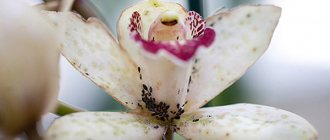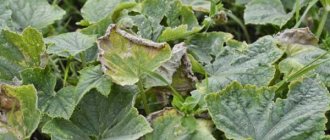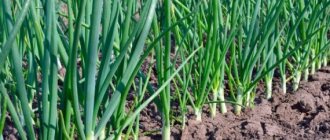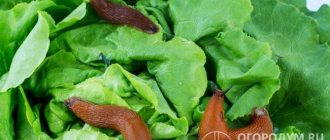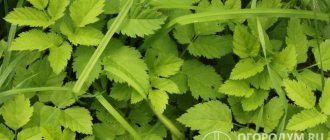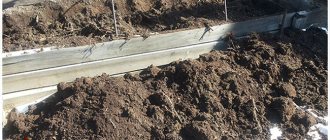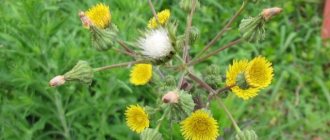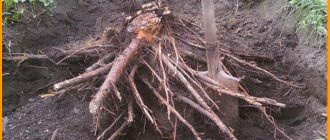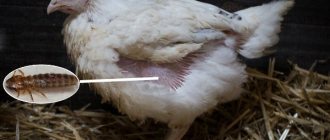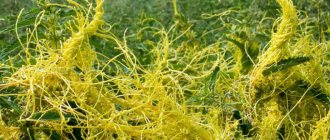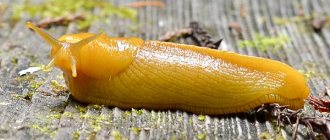Where did Sosnovsky's hogweed come from on my site?
After the war, at the suggestion of Academician Vavilov, Sosnovsky's hogweed began to be introduced into agriculture to make silage from it: this plant grows quickly, gains a lot of weight and does not need care. But the authors of this project did not take into account that hogweed is an aggressive plant that easily invades natural ecosystems and in many cases completely destroys them. Now hogweed is included in the “Black Book of the Flora of Central Russia”. According to various estimates, it occupies 30% of the farmland of Central Russia.
Advice from gardeners
- To destroy large thickets, it is better to contact special services that deal with chemical treatment of land plots against weeds.
- There is no need to burn dried weeds, because their seeds have already fallen into the ground.
- Lupine, goat's rue, wheatgrass, and brome will help to displace hogweed if, before sowing them, you dig up the soil deeply, cover it tightly with agrofibre and spread a layer of soil free of hogweed seeds at least 5 cm thick.
- When working with hogweed, you must protect your eyes - the weed's sap can cause blindness.
- The “Ground” mixture penetrates the weed sap, spreads throughout the plant, burns it from the inside, even the roots. But it needs to be applied in the spring, when the stems are still small and have 2-3 leaves.
Natalia
Author
Ask a Question
It is possible to exterminate weeds if not only local and federal authorities, but also all residents of the state are responsible for the destruction of quarantine plants. Hogweed grows not only on abandoned estates, fields, and landfills. It can be found in the forest, on a personal plot, and on farmland. Preventing the growth of a poisonous plant is not an easy task, but it can be done if all the Russian people want it. Health to you and your loved ones!
How dangerous is Sosnovsky's hogweed for people?
This is a huge poisonous plant. Once on the skin, its juice and even dew under the influence of the sun leave burns that do not heal for a long time. Many times, 3rd degree burns caused by hogweed sap have been recorded, including fatalities - small children died due to extensive skin damage.
In “milder” cases, after an encounter with Sosnovsky’s hogweed, blisters remain on the skin, which do not go away for several months, and can return even after a year if the sun hits the burn site. Hogweed can also cause vitiligo, a disease in which a person’s skin becomes covered with white spots. So far there is no cure for this disease.
How to remove from the site
Not all residents of areas where weeds grow are aware of the dangers of direct contact with hogweed sap. But those who have experienced injuries from burns know that hogweed must be destroyed by all possible means. The danger of poisonous species is that death can occur after severe burns. Splashes of juice imperceptibly penetrate to the surface of the human body, even through clothing.
Hogweed does not reproduce vegetatively and will not sprout from the root if all the buds dormant in the ground are removed. The weed can live for several years, but can bear fruit only once in its life. If you start destroying the weed before it enters the seed ripening period, you can get rid of it. Hogweeds like to grow in sunny areas, do not tolerate excess moisture in the soil, and do not sprout from deep layers of the earth.
Digging up bushes
Hogweed roots penetrate the soil to a depth of 30 cm. The roots have dormant buds that will germinate in favorable conditions after mowing the surface part of the stem. Therefore, the root must be dug as deep as possible - no less than 15 cm, in order to remove it from the ground and not allow the root buds remaining in the ground to sprout new shoots.
If parts of the roots remain in the ground, then it is necessary to pour any chemical substance that corrodes the plant tissue into the hole in the center of the root. These can be herbicides, kerosene, diesel fuel, gasoline, vinegar essence, strong salt solution.
Plowing method
The area where bushes were mowed last year and hogweed roots were dug up is dug up next year in early spring to a depth of 30 cm or plowed up using a walk-behind tractor or a tractor cutter. Plowing of the soil is carried out at least twice with an interval of two weeks. The earth will be freed from roots and will bring a good harvest due to the movement of soil layers and better oxygen saturation.
Mulching with covering material
In order to prevent the roots from germinating, in early spring, areas of the ground where hogweeds were noticed are covered with a dense geo-textile or thick black plastic film. The film must be pressed tightly to the ground with stones and pieces of slate so that the seedlings cannot lift it.
As the weather gets warmer, the black film will warm up; at elevated temperatures, plant roots will begin to steam and decompose. As practice shows, it is not possible to remove the weed in this way in one year. The ground is covered with light-proof dense materials for at least two years in a row.
Trimming inflorescences
Trimming buds can be dangerous. This work is carried out in a protective rubberized trouser suit, a jacket with a hood, goggles, a mask, mittens, and boots. All areas of the body must be reliably protected from accidental splashes of hogweed juice. The inflorescences begin to be cut off before the flowers bloom and only if the plants are very thick and large and cannot be mowed down. Remove umbrellas with small buds, undeveloped fruits, and flowers. The cut parts must be burned.
Burning out with fire
The dangerous method of burning with fire may be ineffective if the hogweed has already scattered seeds around itself. If there are still flowers or unopened seed pods on the plant, then it is doused with a flammable mixture or gasoline and set on fire. First, the ground around the weed must be cleared of dried herbs and dug up or spilled with water. Burning is carried out only for lonely growing hogweeds. After burning, the roots of the plant remain in the ground almost unharmed. They need to be dug up and filled with some kind of chemical.
Replacement seeding
Replacement sowing is carried out after mowing the grass and plowing the soil. Lawn grasses with a powerful root system are sown over the stubble But the germination of replacement grasses will be more effective if a geo-textile is laid on the ground after plowing, a thick layer of soil is laid on it, and then only new seeds are sown.
What is stubble?
Stubble (stubble) - the remains (lower part) of the stems of cereals (cereals) after harvesting
The danger of this method of control is that after a couple of years it may become necessary to control newly sown plants. There is an opinion that only a plant that is even more poisonous and more harmful to humans can cope with hogweed. But it is wrong. It can be dealt with, for example, by goat's rue, wheatgrass, rump, and lupine, whose roots penetrate much deeper and displace all nearby plants.
Read our article: Lupine as green manure
How to remove chemically
It has been proven that in addition to the mechanical destruction of hogweed before the seeds ripen, another of the most effective ways to combat this weed is destruction with herbicides. For this purpose, continuous action preparations “Tornado”, “Tornado 500”, “Grader”, “Gorgon”, Roundup are used.” In the spring, young weed seedlings are treated; in the summer, plants that begin to bush are treated in the root zone.
How to remove using traditional methods
When gardeners discover harmful weeds in their garden plots, they first try to remove them mechanically. Then those areas of land where the roots of the hogweed remain are treated with substances that will kill the remains of the weed.
Sprinkling the soil around the roots of plants with salt is considered an ineffective method of control. But pouring a strong saline solution or vinegar into cut tubular trunks or into the remains of roots helps in destroying young weeds.
Vinegar, or more precisely acetic acid, is injected into the stems of hogweed, after which they begin to dry.
Some farmers fence off pieces of land overgrown with hogweed. Sheep or goats are grazed on these plots for two years in a row. They completely destroy all young shoots of weeds, preventing them from blooming.
Does mowing help with hogweed?
Yes. But subject to several conditions:
- Hogweed should be mowed before flowering begins;
- if you mow hogweed after flowering, the unripe seeds will ripen and be sown on the site (therefore, such hogweed must be burned).
- repeat this activity several times until the root is completely depleted.
- if you pour salt into each tube that remains from the stem of the mown hogweed, the chances of success will increase.
Symptoms after touching hogweed
Under no circumstances should the hogweed be touched with exposed parts of the body.
The action of furanocoumarin is enhanced by the presence of ultraviolet light, high temperature and humidity, as well as heavy sweating of a person who has touched the hogweed. Symptoms caused by furanocoumarin appear within minutes of contact with the plant.
The greatest intensity of symptoms caused by hogweed occurs 30-120 minutes after contact. The fact that it takes a long time for symptoms to appear makes this plant even more dangerous. It often happens that victims of this plant have prolonged and intense contact with it before burns occur. Therefore, the destruction of hogweed is a necessity to prevent undesirable consequences.
Symptoms caused by contact with hogweed increase during the day of contact with this plant. During this time, the skin becomes red and blisters containing serous fluid appear. The inflammation caused by such contact lasts three days. The spots darken over several months. For many years, areas irritated or damaged by hogweed remain sensitive to ultraviolet radiation. Substances produced by the plant cause cancer and birth defects. In extreme cases, such contact can be fatal.
Hogweed causes purulent blisters, which take many years to heal. Scars can remain on the body throughout life. It can cause eye and respiratory damage or anaphylactic shock. Anaphylactic shock can occur when burns from the plant cover at least half the body surface.
There have been cases of amputation of arms and legs due to complications from hogweed burns. Not only is it harmful to touch, but it is also dangerous to be near it, although the effect is not as serious as from touching it. The greatest danger is in summer during flowering.
Animals under threat
Diarrhea, internal bleeding and gastrointestinal inflammation may occur in animals that have consumed the green parts of hogweed. Contact with the plant can lead to both general severe distress in the domestic animal, especially young animals, and to their death. Burns from plants on the udder of a cow are especially common.
Hazard to crops and the environment
Hogweed causes degradation of the natural environment. It often appears en masse, quickly becoming the main representative of the flora in a given place. The plant does not transmit light, preventing its penetration to other plantings and thereby slowing down or stopping their development.
Once hogweed appears in a particular location, it usually becomes the dominant plant species found there. In places of its mass occurrence, the number of other plant species decreases by 2-3 times.
Mechanical method
This is the most labor-intensive method of control, and when the question arises of how to get rid of hogweed in the country, they resort to it if only single specimens of Heracleium are found on the site.
The mechanical method is reliable, but is used only for young weeds with insufficiently long roots. Adult hogweed has extremely strong stems and roots. Neither a shovel nor even an ax will take them. It is problematic to pull out new shoots due to the fragile stem, which immediately breaks off. Watering the plant will prevent the sprout from breaking off.
New growth is cut with a shovel at a depth of 20 to 25 cm of the hogweed roots. It is at this distance from the soil surface that the dormant plant root buds are located. However, after ten days, new shoots may appear, so the process of destroying hogweed must be controlled.
The stem of the plant can simply be mowed. But this must be done before flowering. The first mowing is carried out in early May on young shoots, then continuously throughout the entire growing season of the weed. Hogweed cannot be mowed with a trimmer or electric scythe, which scatter ground particles of grass, and with them poisonous juice. It will be extremely difficult to protect yourself from poison. A lawn mower is best for mowing.
It is also necessary and possible to fight a flowering plant. In this case, one property of the weed is used. Hogweed dies gradually after the seeds are ripe. To do this, only the upper part of the inflorescence is removed. The hogweed will perceive this as the end of ripening and die. The seeds are burned, otherwise they can ripen and contaminate the soil.
Sometimes, as a method of control, burning dried stems with seeds is used. However, this is very dangerous. The fact is that when umbrellas burn, esters containing furanocoumarin are released. They can cause burns to the respiratory tract.
Ways to combat hogweed or get rid of it once and for all
The thing that makes this weed incredibly difficult to get rid of is that it is incredibly tenacious. Hogweed is prolific, scattering seeds five meters around. Seeds can survive in the soil and produce new growth for six years or more. Each of these six years the plant produces new shoots. The question often arises of how to get rid of hogweed forever if the area is already infested with this aggressor.
There are several ways to combat a poisonous plant with varying degrees of effectiveness. Of course, it is best to destroy hogweed while it is young and has not had time to produce seeds. But you can also get rid of an adult weed.
The main methods of destruction include:
- mechanical (digging, mowing);
- agrotechnical (mulching, lawn seeding);
- biological (use of cutworm caterpillars);
- chemical (use of pesticides).
A good result is obtained if you combine individual methods of weed control.
What threatens a careless summer resident
Photo: https://pixabay.com/photos/girl-summer-hogweed-nature-blonde-2640478/
Every owner of a country plot should know about this. According to Law No. 191/2014-OZ of December 30, 2014, as well as amendments to it, land owners in the Moscow region are obliged to destroy Sosnovsky's hogweed by chemical, agrotechnical or mechanical methods. This applies to everyone.
According to Art. 6.11 of the Code of Administrative Offenses of the Moscow Region, violators are punished with a fine (thousand rubles):
- citizens – 2-5;
- officials – 20-50;
- entrepreneurs – 150-1000.
In other words, a businessman who grows, for example, strawberries in a greenhouse for sale and does not destroy the hogweed at his dacha in time, risks receiving a fine in the amount of up to 1 million rubles!
It is important to remind about personal protection measures! You need to wear gloves when working, and if juice gets on your hands, immediately wash them with soap and water. Then the skin is wiped with a cotton pad soaked in furatsilin, and the treatment is completed with Panthenol and taking your usual antiallergic medication.
Chemical method
If we are talking about how to effectively get rid of hogweed, then the chemical method has no competitors. To control the weed, Roundup or its numerous modifications containing glysophosphate are used. However, the chemical must not be sprayed.
Heracleum has a hollow stem, so injecting a herbicide solution through a syringe gives excellent results. The active substance thus quickly penetrates the root. Within a week or two the plant dies. You need to monitor the site for several more years, because there may still be seeds in the soil. Traditional chemical methods include table vinegar, which is injected in the same way as herbicides.
The story of the "migrant"
Attempts to introduce alien plants into culture often lead to negative consequences - after all, the aliens can get out of control. Sosnovsky's hogweed is one of the most striking examples of an ill-considered invasion of nature. Initially, it was planned to be used as a fodder plant, for which they began to sow it en masse in the fields. But the quality of silage from plants grown in central Russia turned out to be quite low. As a result, the idea of processing hogweed for livestock feed was abandoned, and the plant remained in the fields, turning into a serious problem.
Attention
If you are ready to fight hogweed, do not forget to reliably protect all parts of the body. It is better to carry out work in cool, cloudy weather.
What is a plant?
Hogweed is a biennial plant, less often a perennial one. The height of its stems, depending on the type, can range from 20 cm to 240 cm. They are usually hollow with slight pubescence. Only the inhabitants of the northern regions are completely pubescent.
The leaves of the weed are quite large, long-petioled, and located in a rosette. They can be trifoliate, doubly trifoliate, or pinnately divided, and the shape of the segments can be different.
The flowers can be white, hot pink or greenish-yellow, forming a complex umbrella up to 40 cm across. Many species bloom in June, although most can continue flowering until August.
The fruit is a special type of two-seeded plant called the viscocarp. Seed ripening occurs from July to September. The seeds quickly fall off. Hogweed is considered a monocarpic plant - it blooms once and dies as soon as its fruits ripen.
